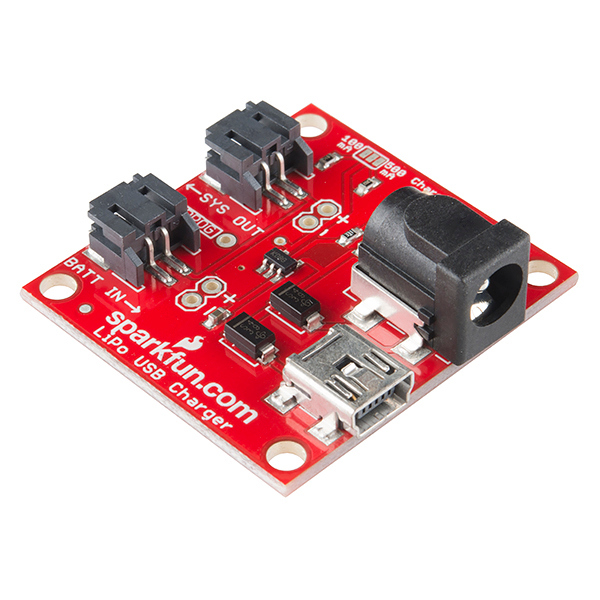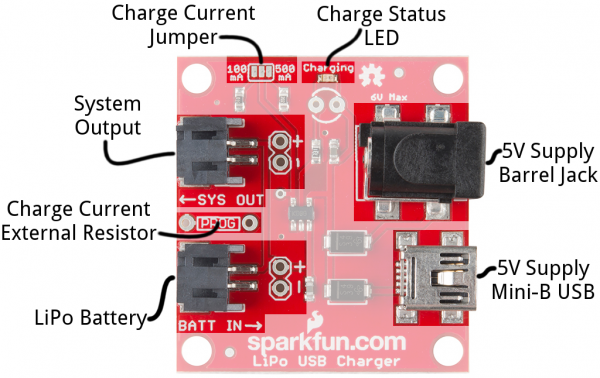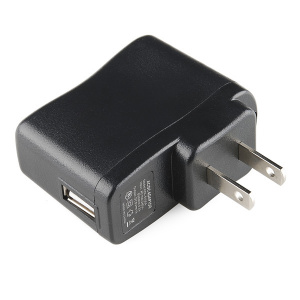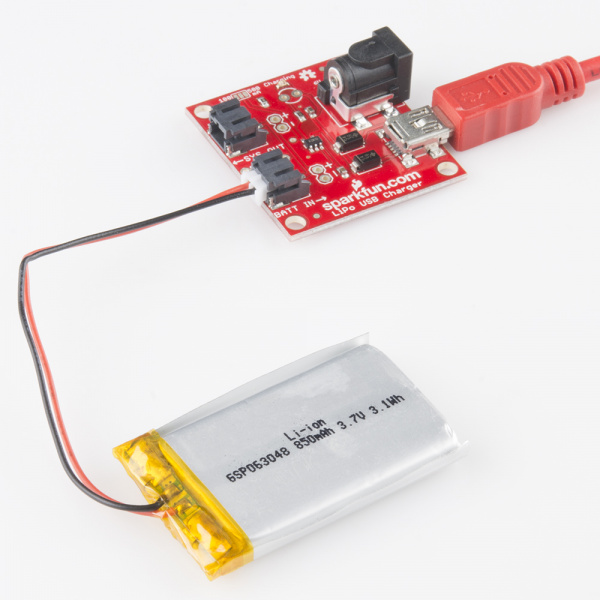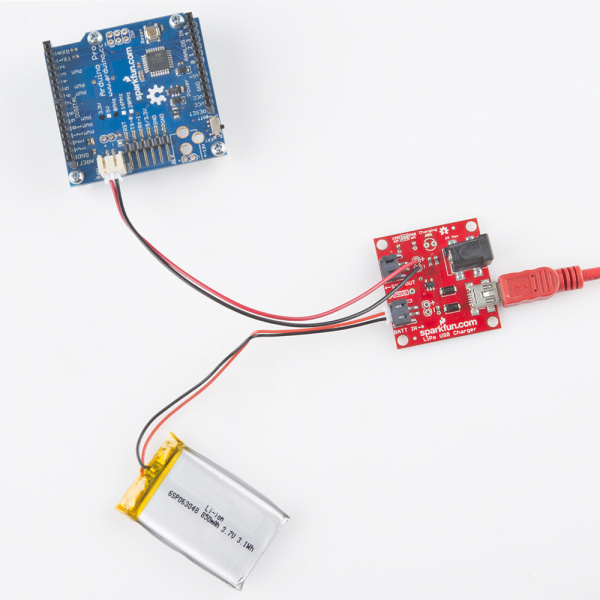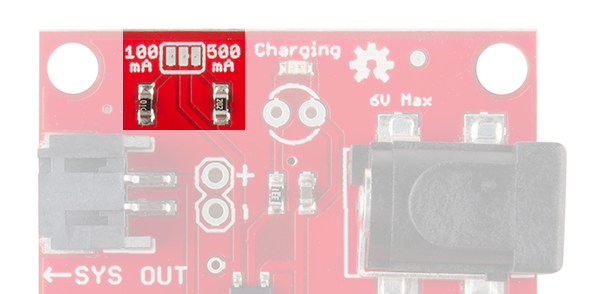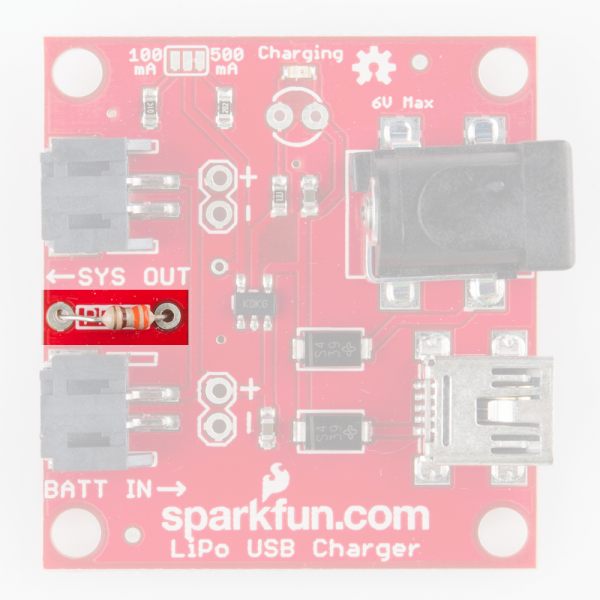LiPo USB Charger Hookup Guide
Introduction
We love LiPo batteries! They pack a walloping, power-supplying punch in a tiny, flat package. And, they're incredibly easy to recharge, when that time comes. If you're looking to make your project mobile and easily rechargeable, we can't recommend this pairing enough: an 850 mAh LiPo battery and an embeddable USB LiPo charger.
This tutorial will explain how to use the USB LiPo Charger with any of our single-cell LiPo batteries. We'll focus on the LiPo Charger and Battery Retail kit, but this information can be applied to that charger and any compatible battery.
Required Materials
- USB LiPo Charger
- A single-cell LiPo battery
- A 5V power source, options include:
- A computer USB port with attached mini-B USB cable
- A USB Wall Adapter and mini-B cable
- A 5V Wallwart Supply
Suggested Reading
Voltage, Current, Resistance, and Ohm's Law
Battery Technologies
How to Power a Project
Inputs and Outputs
On this page, we'll dissect the USB charger, examining all of the inputs, outputs, and specifications of the board.
Charger Input -- Power Supply
First, you'll need something to supply power to the charger, so it can regulate power to the battery. Connect your power supply to one of these two inputs: a barrel jack (5.5mm outer diameter, 2.1mm center pole, center-positive) or a mini-B USB connector.
Your power supply voltage should be between 4.75 and 6V. A 5V USB supply -- from a mini-B cable connected to either a computer USB port or wall adapter -- makes for a perfect power source. Or, if you want to use the barrel jack input, we recommend the 5V wall adapter.
The current requirements of the supply will depend on how you've set the charge current on the board. By default, the charge current is set to 500mA, so make sure your supply can handle that. Computer and laptop USB ports are most suspect here; 500mA is the defined max a port can supply, and oftentimes they're set to have an even lower output than that (e.g. 100mA).
You can safely attach both a 5V wall-wart and USB supply to the board. There is some protection (diodes!) on-board to prevent reverse current. The higher-voltage supply will source power to the chip.
Charger Output -- Single-Cell LiPo Battery
Once you've connected a power supply to your charger, the next step is to connect a battery. This board will only charge a very specific battery, make sure it meets these requirements:
- Single-Cell Batteries Only -- Your LiPo should have a nominal voltage output of about 3.7V, and get up to around 4.2V at a full charge. That means single-cell LiPo's only. If you have a multi-cell battery -- something with a nominal voltage of 7.4V or more -- this isn't the charger for you.
- Battery Chemistry -- The charger will only work with Lithium-Polymer or Lithium-Ion batteries.
- Capacity Considerations -- To avoid explosions (which are only very briefly fun), you shouldn't charge these LiPos at a current over 1C. That means a 500mAh battery shouldn't be given a charge current over 500mA, a 100mAh shouldn't be charged higher than 100mA. This board is designed to charge at 500mA out-of-the-box, but it's easy enough to change that rate. See the next page if your battery's capacity is under 500mAh.
All of our compatible batteries are terminated with a white JST connector, which you can plug directly into the mating black connector next to the BATT IN→ label. If your battery is terminated with some, weird, non-JST connector, you can also use the un-populated 0.1"-pitch header directly behind the JST connector. Wires or other connectors can be soldered to this header, if desired.
System Output
The LiPo USB Charger is designed to be easily embeddable inside a project. The ←SYS OUT connector allows you to connect your battery output to the remaining parts of your project.
As with the battery connection, you can use either the JST connector or the nearby 0.1"-pitch header to connect your project.
The SYS OUT output will connect your project directly to your battery. That means the battery supply voltage (somewhere between 3.6 and 4.2V) will power your project. Make sure you regulate that as necessary.
Charge Status LED
The on-board red Charging LED can be used to get an indication of the charge status of your battery.
| Charge State | LED status |
|---|---|
| No Battery | Floating (should be OFF, but may flicker) |
| Shutdown | Floating (should be OFF, but may flicker) |
| Charging | ON |
| Charge Complete | OFF |
If you want to add your own, larger LED, there's an unpopulated footprint where you can solder either a 3mm or 5mm LED in the tiny (but bright!) red LED's stead. Make sure you get the polarity right, though.
Setting the Charge Current
Before you plug a battery into the charger, you should be aware of your battery's capacity and the charge current supplied by the charger. To be safe*, you should keep the charge current at or below 1C of your battery. That means you should charge your 850mAh battery at 850mA or less, and a 100mAh battery at 100mA or less.
The charge current controls how fast your battery will charge. If you have a 1000mAh battery, charging at 1000mA will fully charge that battery in 1 hour. Charging it at 500mA will mean a full charge takes twice as long -- 2 hours. So more charge current is better...as long as it doesn't exceed your battery's specifications.
The featured component on the LiPo USB Charger board -- an MCP73831 -- has a programmable charge current feature. It can be set to deliver anywhere between 15mA and 500mA to a battery. To program that value, a resistor is connected from the PROG pin to ground. There are already two resistors on-board, which can set the charge current to either 500mA and 100mA. A small jumper is used to select between those. You can also add your own resistor, to set a custom charge current.
Jumper-Selecting
Next to the charge-status LED there are three bare pads that form a two-way jumper. The center pad connects to the MCP73831's PROG pin, and the outer two pads connect to a pair of resistors. The labels next to those outer pads indicate the charge current that they set.
If you look really closely at that jumper, you may see a small trace connecting the middle pad to the 500mA-labeled outer pad. As such, this board is configured to deliver a 500mA current by default.
To change the charge current to 100mA, you'll need to cut that small trace between the pads (a hobby knife is recommended), and apply a solder blob to connect the 100mA-labeled pin to the center pad.
Custom Charge Current
If neither 100mA or 500mA will work for you, there is an unpopulated resistor footprint to allow you to set a custom charge current.
Before adding the resistor, disconnect both jumpers discussed in the section above. Then use this equation to select your resistor:
For example, if you want to charge a 400mAh battery at exactly 400mA, solder in a 2.5kΩ resistor (you may have to series a 2.2k and 330).
* Most batteries include over-current protection -- implemented on the little circuit board under the yellow tape -- which will keep the battery from blowing up if you supply too much current. But it's best to not rely on that circuit: you'll save power and your sanity.
Resources and Going Further
- LiPo Battery Care Tutorial -- An older tutorial, but much of this info still holds true. This will give you some info on strain relief, and some hints on safely disconnecting a battery from the charger.
- USB LiPo Charger Schematic -- If you have any circuit-level questions about the LiPo charger, check out the schematic.
- MCP73831 Datasheet -- Get the low-down on the MCP73831 single-cell LiPo charge management IC.
- USB LiPo Charger GitHub Repository -- This is where we keep the most up-to-date design files.
Now that you've got a replenishable source of power, how are you going to use it? Need some inspiration? Check out these tutorials:
- Uh-Oh Battery-Level Indicator Hookup Guide -- Learn how to assemble and use the Uh-Oh Battery Level Indicator Kit. You'll be notified if your battery voltage falls too low.
- MYST Linking Book -- Use a LiPo to power your very own Linking Book from the classic computer game, MYST.
- Sunny Buddy Solar Charger Hookup Guide -- If you ever want to replace the LiPo USB Charger with a solar charger, check out the Sunny Buddy!
